How to Adapt the Warp Sett for Your Fabric
Marcy Petrini
July 2019
At the Beginning….
People generally learn to weave with plain weave. To start the project we need to explain the sett. We wrap the yarn around a ruler, count the threads in one inch, and explain that we call the measurement the yarn size or grist or diameter (d) in wraps per inch (wpi) and that we will use half that number for our sett in ends per inch (epi) because our finished product will have half warp and half weft; then we hand the rulers to the students and let them try, admonishing not to overlap the threads and not to leave empty space in between them, as show below.
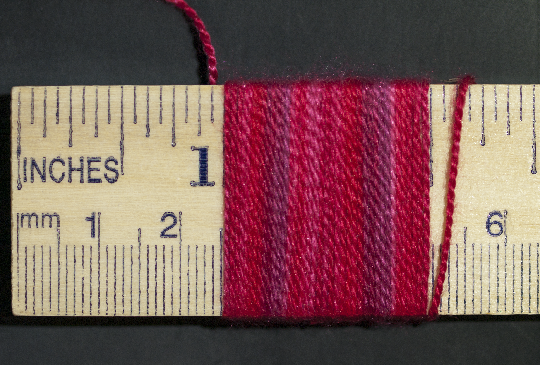
As the old saying does, “you gotta start somewhere”. We may mention that we will explain for future projects how the sett varies, but first impressions are powerful.
So, there was the time we used a 5/2 cotton sett at 16 epi – and 16 epi became “the sett” – for everything (“you told me to sett it at 16”); or the time that we used 3/2 cotton sett at 12 epi in a 12 dent reed and the conclusion was that the reed determines the sett, and not the other way around.
Those are rare instances, no doubt, but I do think that beginning weavers sometimes are looking for a magic number. “What’s the sett for 10/2 cotton?” asks the e-mail. Ah, if only sett were that simple! But with a bit of thought and understanding, it doesn’t have to be that hard, especially since we have some leeway.
The Determinant of Sett
Let’s look at all the assumptions that the instructors make for that first project:
|
Structure: plain weave |
The sett is diameter (d) divided by two – but only if the following two determinants are true |
|
Weft: same size of the warp |
The sett has to be adjusted if the weft is larger or smaller than the warp |
|
Balanced fabric |
50% warp and 50% weft on both sides of the fabric; usually, but not necessarily, true with plain weave if the weft grist = warp grist |
|
Yarn and Fiber |
Not too slick; we usually don’t start weaving with slick silk |
|
Final use |
A tablemat should be sturdy not flimsy, a scarf should be flowing not stiff. A rug can be totally warp-faced or weft-faced |
|
The Weaver! |
In starting out, we assume that the weaver will be “average”, but as time goes on, we learn what our personal preferences are. Experience! Experience! Experience! |
Let’s look at these individually and see if we can use some principles.
Structure
Plain weave has the shortest floats, each weft goes over and under each warp thread, each warp thread over and under each weft thread.
But when we have longer floats the fabric can be unstable, too much wiggle room as shown in the picture below, where the warp ends bunched together.
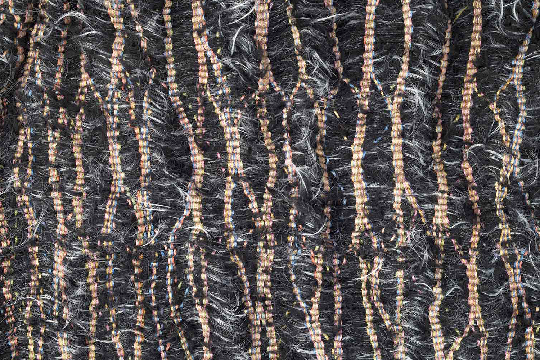
When we have floats, we adjust by setting the warp more closely.
How much more closely?
For twills, a rule of thumb is that balanced twills should be sett at least 20% closer than plain weave. For that 5/2 yarn that we sett at 16 epi for plain weave, we would use 20 epi for a twill.
Grouped weaves form lacey blocks and plain weave. You may read that lacey weaves should be sett more openly, the same or closer than plain weave. All of those are true and the sett varies on the proportions of these. If there is a lot of plain weave, we may want to use a more open sett to accentuate the lacey areas; if there are a lot of lacey blocks, then the sett should be a bit closer because the floats can make the fabric unstable. A huck lace that has all lace and no plain weave (except the selvages) using 10/2 Tencel® usually sett at 24 epi for plain weave, I may sett it at 26 epi.
Supplementary weaves have a ground of tabby, but the supplementary weft is generally larger than the ground weft, which is traditionally the same as the warp. In this case, I open up the tabby sett a bit, to allow room for the supplementary weft. A 10/2 cotton, that may be sett at 24 epi for tabby, I sett at 18 epi for a tabby of a supplementary weave.
There is actually a formula for calculating the sett for different structures, but while I used to really like to use it, with time I found it unreliable for some unbalanced structures, and those that have different size floats with different picks, for example a birds’ eye twill.
Fortunately, we don’t have to do any calculations from the formula to find reasonable setts. While there are lots of sample setts on the web for the various commonly used yarns, there are differences in twist in yarns which effect the sett. The best place to find the sett for a specific yarn is to use the web site of the yarn vendor.
Manufacturers of yarns may provide either a range for setts or ranges for plain weave and twills. For example, for 10/2 cotton, the sett suggested may range from 18 to 36 epi. The 18 is for drapeable plain weave or a lacey structure with lots of plain weave, for example used in a scarf; the 36 is for unbalanced twills. About in the middle is a balanced twill, 24 epi.
Alternatively, the sett suggestions may say: plain weave: 18 - 24; twill 24 - 36; in this case, the 24 is suggested both for a sturdy plain weave, for example to be used in a placemat, or a balanced twill. The suggested setts for a given yarn usually take into consideration the fiber, so they are worth noting, even when wrapping the yarn to determine its grist.
Warp and Weft Size
Often, we use the same size weft as the warp, but sometimes the perfect yarn for the project is larger or smaller.
If the weft is larger than the warp, the sett must be more open to make room for the weft; if the weft is smaller than the warp, the sett must be closer to avoid the weft to pack in and make the cloth too stiff.
For example, for 10/2 cotton woven in plain weave for warp and weft, the average sett is 24 epi. For the runner below, woven with a larger ribbon, the warp was sett more openly at 18 epi.
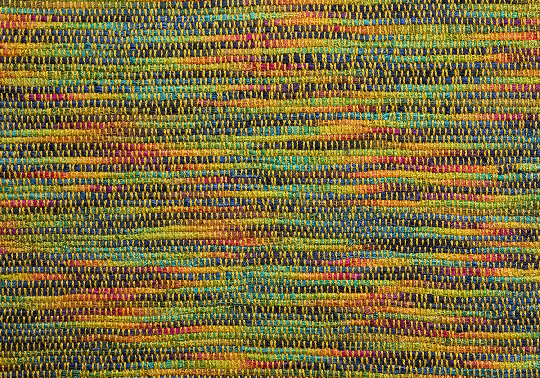
The scarf below was woven with a multicolor 5/2 bamboo for warp and a purple 10/2 bamboo for weft in a twill. For a balanced twill, the sett of the 5/2 warp would have been 20 epi, but because the weft is smaller, a sett of 24 epi was used. This makes the fabric more stable but also allows the multicolor warp to be the focus of the scarf while still having good drape.
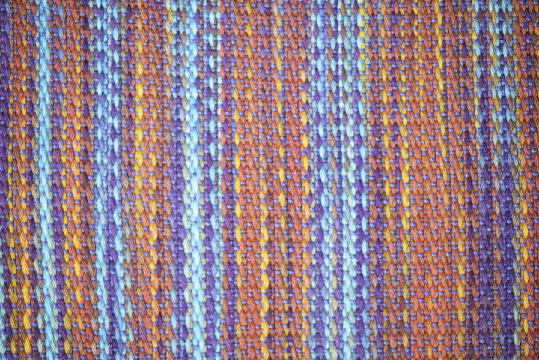
Balanced and Unbalanced Fabrics
A balanced fabric is one where the same amount of warp and weft shows on each side; both plain weave and 2/2 twills can be balanced, if we use the same size warp and weft.
In an unbalanced fabric, the weft shows more on one side, the warp on the other as shown in the picture below of a 3/1 twill, front and back; 3/1 means that for every shot, 3 threads remain down while 1 thread is lifted.
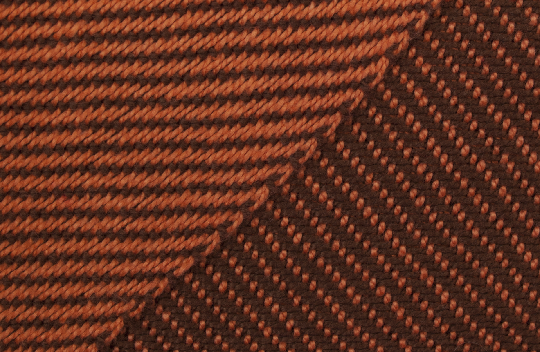
How do we sett the warp for these fabrics? Closer than for a balanced twill. I already mentioned that when vendors give a range for twills, the upper value is for unbalanced fabrics. Let’s use the example of 5/2; we may sett it at 16 for plain weave, 18 for a balanced twill, and 22 epi for the 3/1 twill.
Yarn and Fiber
The general sett recommendations for 10/2 unmercerized cotton, 10/2 mercerized cotton and 10/2 Tencel® (which follows the cotton count) are the same. But there are differences. Look at the photo below:

There are 6 wraps for each of the three yarns, which are: 10/2 unmercerized cotton (blue), 10/2 Tencel® (rust) and 10/2 mercerized cotton (yellow), occupying the portion of an inch as labeled. Translated to epi, the setts would be 19, 20 and 23, respectively, with some differences, especially between the unmercerized and mercerized cotton; visually, I can see that the yellow yarn has a higher twist than the others. This is not surprising as I have found differences between mercerized cottons of the same count and Tencel® of the same count. In using the yarn, such differences may not matter, but I still think it is important to consult the yarn vendors for their sett recommendations.
Silk is the one fiber that benefits from a closer sett as it is very slippery. Luckily, all silk yarn vendors have helpful tables for their yarns.
Final Use
I wouldn’t use 3/2 cotton to make a scarf, the fabric wouldn’t drape as well as I’d like, but 3/2 makes great mats; for a scarf, I would use 10/2 cotton, which I wouldn’t use for a table mat, I think the sturdier 3/2 works better.
In between is 5/2; it could be used for a scarf and for a matt – but not with the same sett. For a scarf I may use an open 18 epi, for a matt a tighter 20 epi.
The ranges given to us by manufacturers are rather close, but we have a lot more leeway. To weave a tapestry or a weft-faced rug, we sett the yarn 5 or 8 epi, depending on the size of the weft, so we can cover the warp totally, on both sides of the fabric, as shown in the photo below, front and back.
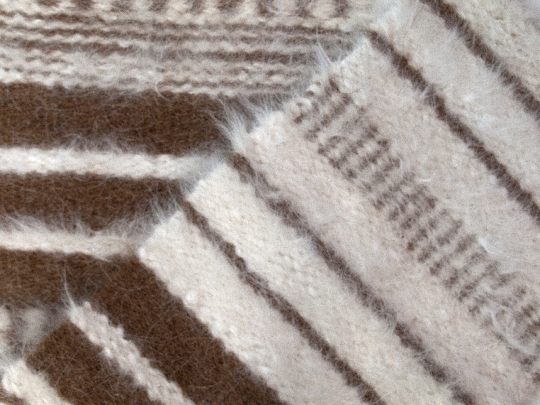
At the other end of the spectrum, we can weave a rug with rep weave, warp-faced plain weave; we sett rep close to 4 times the yarn wraps per inch, to make sure that the top and bottom of the fabric are both solid warp, as show in the photo below, front and back.
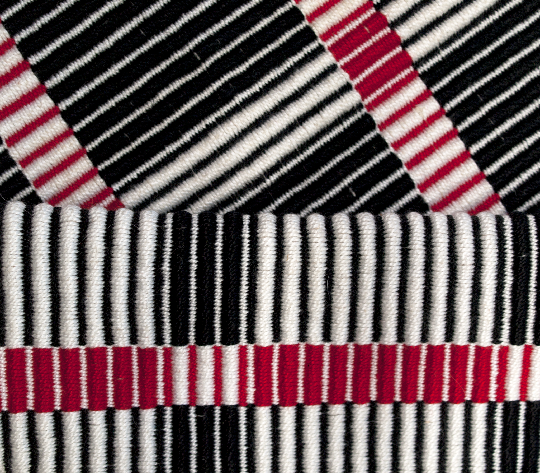
Think carefully about the final use for a perfect project!
The Weaver!
As we weave, we find our preferences; some weavers like their warp tension high, some low; some like to beat hard, others softly.
Which combinations you prefer may impact your fabric; if you like to beat hard, you make great rugs – what if you want to weave a scarf? You can adjust the sett.
I know that I like to beat rather hard – not as hard as beating a rug, but certainly to weave lacey weaves, I have to fight my tendency. I also like to keep my warp pretty tight, which minimizes possible threads getting caught in the middle of the shed, especially with a sticky warp.
Rather than fighting my tendencies, I adjust the sett. By using a slightly larger ends per inch than recommended, my warp will provide some resistance to the beating; and since a tight warp also promotes heavy beating, the closer sett helps with this tendency as well.
Pay attention to what you like and learn over time to adjust accordingly.
Where Do I Go from Here?
You see why I couldn’t answer that email “What’s the sett for 10/2 cotton?” with a single number, but here is a plan to get started. And, no, I won’t use the dirty 6-letter word (sample), although sometimes that’s the best way to get the answer.
Let’s say you have chosen the yarn and the structure, and you know what you want to make.
- If you have to buy the yarn, use the high end of the sett for your calculations for the yarn purchase, so you won’t run out of yarn.
- If you have the yarn, or when the yarn arrives, do the following:
- Wrap the yarn around an inch, as described above, no overlap, no empty spaces, divide by half; this is your starting epi.
- Think about adjustments for the pattern, the weft size if different than the warp and what your finished product is going to be; adjust the starting epi accordingly; sometimes your adjustment may be a calculation (20% increase for twills), sometimes it’s “a little bit” higher or lower – 18 or 14 instead of 16, don’t use odd setts; if your calculations give you 21 epi, use 20 or 22, depending on what you are making.
- Compare the adjusted epi you have just calculated with the values recommended by the yarn vendor:
- If you agree, you are good to go! Go wind that warp!
- If you don’t agree, figure out why:
- Are you making a very sturdy piece that requires a higher sett than recommended?
- Are you using a slick yarn, like silk, so the vendor is recommending a closer sett than you had calculated?
- Make your final decision and proceed with warping.
- If when you start weaving you find that your sett is not quite right, you can re-sley, remembering that there can be two potential issues:
- The width won’t be the same; if you need to re-sley with a closer sett, the width will be less; more open, the width will be more.
- Depending on the adjustment, there could be a potential tension problem because the threads no longer will travel a straight line from the back of the loom to the front, they will either fan out or squeeze in, depending on the direction of the new sett.
- An alternative to re-sleying is to change weft size, which is a cleaner solution:
- If the sett is too open, use a larger weft.
- If the sett is too close, use a smaller weft.
- Once you are done, keep notes. This is the most important part for future use. Keep a spreadsheet if you are comfortable with them, or a table of some sort. List the following:
- Warp yarn used, be specific – not “cotton”, but 8/2 unmercerized cotton.
- Weft yarn used, say at least “same as warp”, if that’s the case.
- The structure.
- Final use of the piece.
- The sett in epi.
- Your impressions: note whether you are totally happy with this sett, or whether you are relatively happy but next time you may sett this yarn more closely or further apart. And, yes, do this even if the project turned out not to be to your liking. That may be the best lesson.
- Any other thing you may want to remember.
- When reading a published project, note the same information as above, even if you don’t plan on using it. Add it to your table or make a parallel table of use by other weavers. You can compare your setts with those of others and make conclusions about similarities and differences.
Soon you will have a table – your table – which will give you a feel for how you like to sett various yarns. Experience comes from paying attention to what we do right – and what we do not so right.
Happy weaving!
Please email comments and questions to
Last edit: 12/5/2023. Corrected "Unit Weaves" to "Grouped Weaves"
